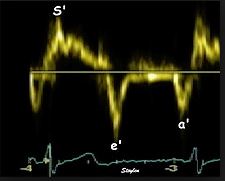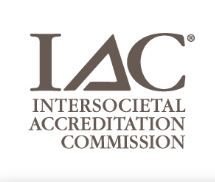The Intersocietal Accreditation Commission updated the standards and guidelines for Adult Echo accreditation in July 2017 with a December 1, 2017 effective date. The main changes to the adult echo standards is the mandate (versus option) to evaluate diastolic function on all studies, and to report on it. With this requirement followed the requirements for all ultrasound equipment to have Tissue Doppler Imaging capabilities. With so much advancement in diastology, it is great to see the IAC add this requirement as a component of a complete echocardiogram.
ADULT ECHO UPDATES
- The patient’s blood pressure must be measured and recorded prior to or during the exam

- Echo Exam must include evaluation of diastolic function through a combination of PW and TDI
- Measurement of the LV may include 3D and/or volume measurements
- Reporting requirements:
- Comment on the presence or absence of LV regional wall motion abnormalities
- Comment on diastolic function (this used to be optional)
- Equipment:
- Ultrasound equipment must be able to perform Tissue Doppler Imaging (TDI)
- Display or DICOM header must display name of institution, patient name, date and time of study
- ECG must be displayed
- Guidelines – These are not mandated standards but rather suggestions and guidelines:
- Contrast studies should be strongly considered when patients are technically difficult
- Strain imaging is optional
STRESS ECHO UPDATES
- Reporting requirements:
- Clarity on correct reporting of blood pressure was provided
- Correct reporting on blood pressure includes reporting, “Resting blood pressure and blood pressure response to exercise stress echo”
- Acquisition:
- Remember that the timer should start at the end of peak exercise.
- We often see peak images acquired at :02 seconds. This indicates that it was 2 seconds into image acquisition and that the time it took for the patient to get off the treadmill, onto the stretcher and into position was not counted.
- Please remember that the timer should start as soon as the exercise ends.
- Most US systems have the ability to start a timer independently from the acquisition button.
- The new guidelines require, “An image acquisition timer must be displayed”
THE PROPOSED CHANGES FOR PEDIATRIC ECHO APPLY TO THE TECHNICAL DIRECTOR OF THE LAB AND INCLUDE:
- Credentials:
By January 31, 2022, the Technical Director must have obtained an appropriate credential in pediatric echocardiography. This means that in the year 2022, the technical director of an accredited pediatric echo lab must hold pediatric credentials instead of allowing only adult echo credentials. The good news is that the IAC has provided plenty of notice! This requirement does not kick in until 2022! Plenty of time for us all to study, study, study and no need for anyone to be caught of guard.
- Facilities with no sonographers:
In a facility with no sonographers, the Medical Director serves as Technical Director. If the Medical/Technical Director is not credentialed in pediatric echocardiography, at least one other sonographer must be credentialed in pediatric echocardiography and that person must be designated as the co-Technical Director.
ECHO ACCREDITATION UPDATE SUMMARY
- Adult echo main changes involved including diastology assessment and reporting. For more information on diastology, check out our recent blog series:
- Emphasis was placed on obtaining the patients blood pressure at the time of exam. Learn more about the importance of blood pressure during the evaluation of valvular disease:
Need help? The staff at the Intersocietal Accreditation Commission provides many resources and tools to assist you through the accreditation process. You can review a copy of their complete Standards and Guidelines on their website here. In addition, our team at CardioServ is always here to help. Have questions or need help? Just give us a call or contact us for a proposal.

Judith Buckland, MBA, RDCS, FASE, President






